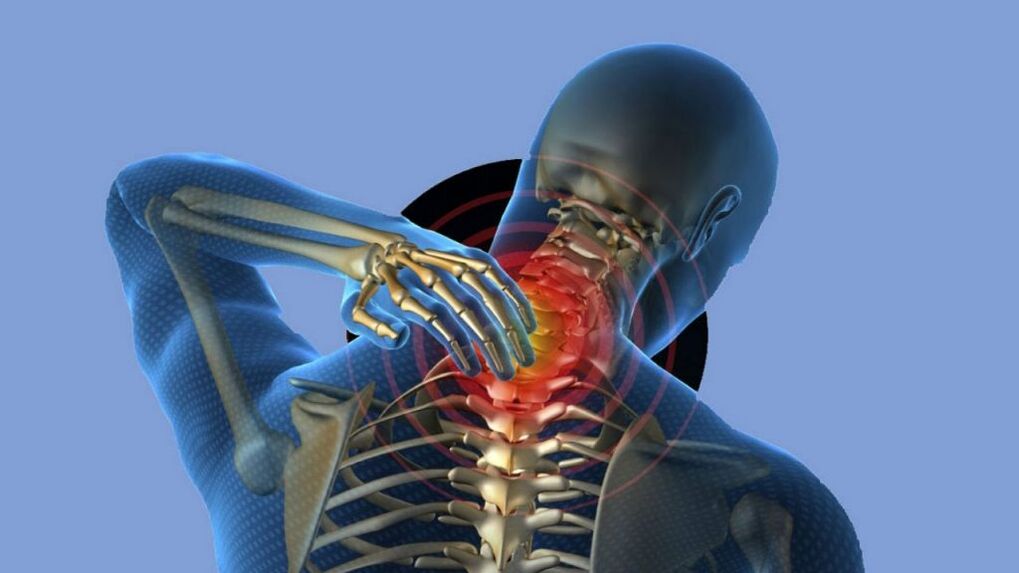
Under the osteochondral of the cervical vertebrae, it is a degenerative nutritional pathology that affects the intervertebral discs between the vertebrae.The disease is mainly diagnosed in people between 30 and 50 years old, but can occur at different ages.It is important to determine the pathology in a timely manner and provide appropriate treatment.If this is not done, the disease will transition into a new developmental stage, which may lead to the need for surgical intervention to replace the disc.
Causes of the disease
Osteochondrosis occurs in the neck due to the following reasons:
- A sedentary lifestyle;
- obesity;
- Improper nutrition;
- Previously suffered spinal injuries, especially if the subdivision of the cervical area is damaged;
- Excessive physical exercise;
- The head that is tilted for a long time remains in the same position - therefore, pathology is often diagnosed among office workers working in computers;
- Genetic tendency;
- Unstable emotional background;
- The neck is hypothermia;
- autoimmune pathology due to the development of cartilage tissue injury;
- Incorrect structure of the spine diagnosed at birth.
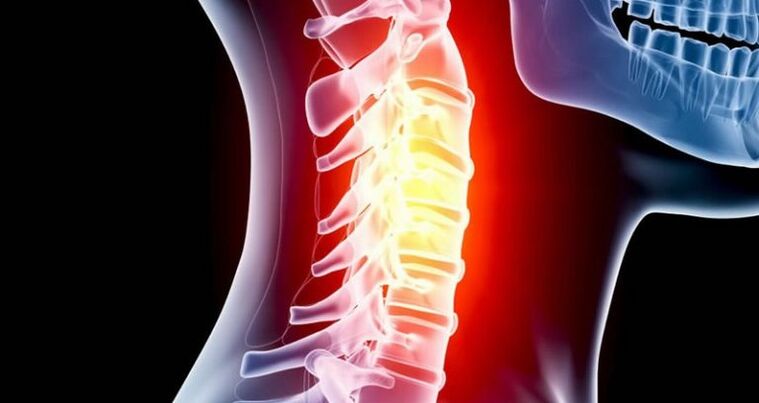
Genetic susceptibility also promotes the development of osteochondrosis in the cervical region.
Disease degree and type
Cervical osteochondrosis has gone through multiple developmental stages, each with certain symptoms:
- The first stage of disease.This is the beginning of pathological development.The patient suffers from pain in the affected area, which can be exacerbated during exercise.This stage is characterized by back muscle tension and rapid fatigue.Pathology at this stage does not require treatment.The disease can be eliminated using the right power system, exercise treatment and abandoning harmful dependencies.
- The second stage of pathology.The disease progresses, affecting the intervertebral disc.Their height is reduced, resulting in a decrease in the distance between the vertebrae and nerve clamping.As a result, pain syndrome becomes more pronounced.He intensifies when his head moves and sends him to his shoulder or hand.This symptoms also occur - lack of concentration and pain in the head area.To treat pathology, prescription medications are prescribed.
- The third degree of the disease.A hernia in the intervertebral disc begins to form.Pain syndrome is enhanced.The pain is located on the neck and head and reaches to the shoulders and hands.Dizziness occurs and the patient is very weak.The neck lost its fluidity.Especially in the morning I feel acute.
- The fourth stage of the disease.The disc was completely destroyed.Their location is occupied by connective tissue.The pain will increase, and it will not disappear even during sleep, the neck almost stops turning completely, dizziness becomes more frequent, the patient loses coordination of movement and noise in the ears.
Clinical pictures
Schop osteochondrosis manifests in different ways, depending on the lesion in a particular segment.However, the general symptom characteristics of any vertebrae injury in the department are:
- Head pain syndrome, for chest, arms, shoulders;
- vision and hearing;
- Tighten when moving your neck;
- numbness of fingers on the upper limbs and the end of the tongue;
- Weaknesses in the arms, leg muscles;
- Blood pressure rises.
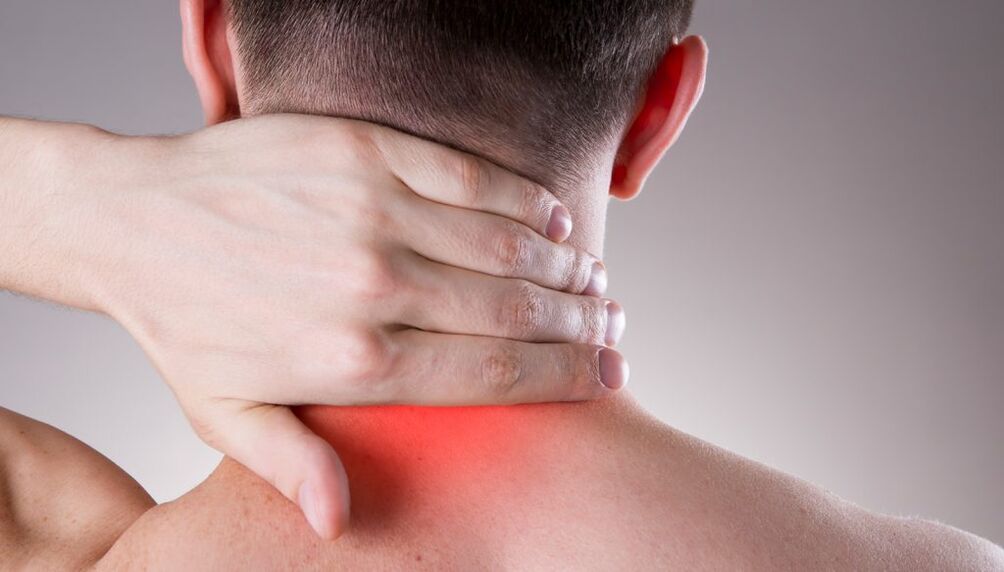
Pathology is also characterized by certain syndromes, each of which is discussed in detail below.
Radio syndrome
Using cervical osteocartilage degeneration, the nerves are pinched, and thus flowing pain syndrome occurs.Pain brought to the shoulders and hands.The following symptoms also occur:
- The small papules on the bottom of the hair on the epidermis are called chicken skin ump.
- Skin tingling;
- Loss of elasticity and elasticity of the epidermis;
- Swelling of soft tissue;
- Pale skin.
Driven arterial syndrome
Characterized by the following symptoms:
- Burning or pulsation, constant or paroxysmal pain, exacerbated when the head moves or stays in a position for a long time;
- Dizziness and fainting;
- nausea;
- Loss of flow coordination;
- noise and hearing worsen in the ears;
- Eye pain;
- Visual field of view.
Cervical migraine syndrome
If osteochondral disease occurs in the cervical spine, this may lead to the occurrence of cervical migraine syndrome.In this case, the nodes of the sympathetic column are stimulated.As a result, there are problems with the cerebral blood vessels and blood circulation.This causes a regular increase in blood pressure, characterized by the following symptoms:
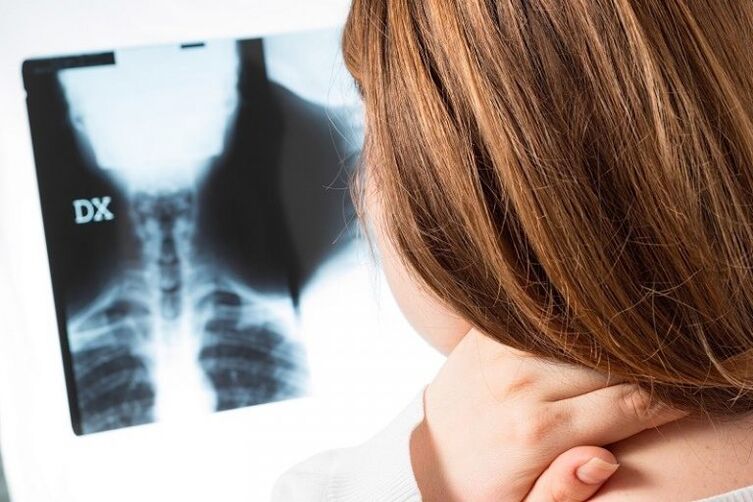
- Heart rate;
- ear noise and ringtone;
- Hearing worsens.
Hypertension syndrome
If osteochondrosis in the cervical spine causes the occurrence of hypertension syndrome, the patient will increase intracranial pressure.This symptom occurs:
- Pain outbreak;
- Nausea and vomiting;
- Body temperature rises.
When examining the blood, an increase in red blood cell sedimentation rate will be indicated.
diagnosis
For the diagnosis of pathology, instrumental research and laboratory testing are prescribed.
Musical instruments
If there are signs of cervical osteochondrosis, it is recommended to consult a doctor.Only experts can diagnose pathology.To this end, professionals have stipulated such tools for research:
- X-Thunder.Such studies are rarely prescribed because it does not have a complete understanding of pathological development, especially regarding the fourth stage of the disease.
- CT.It helps determine changes occurring in the vertebrae.However, the study cannot determine the presence of a hernia between the subdivisions, meaning he will not say anything about its form and novel.
- MRI.It helps identify any behaviors that violate the spine, including disc hernia.
- Duplex ultrasound.Such studies are prescribed if problems with blood circulation on the cervical vertebrae are suspected.Double-stranded ultrasound will show the presence of bleeding disorders, as well as obstacles that interfere with normal blood processes.
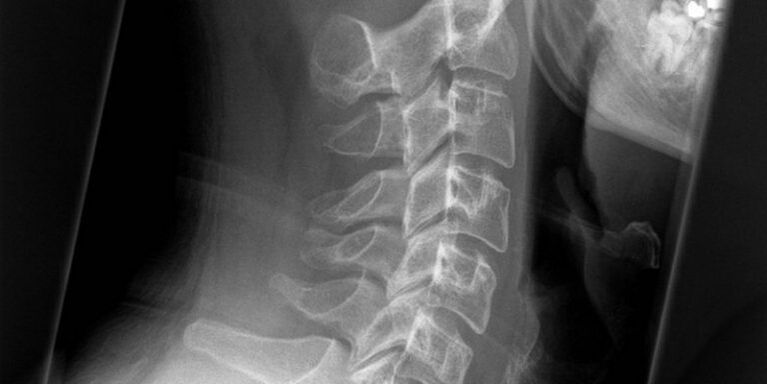
laboratory
It also prescribes general and biochemical blood tests for cervical osteochondrosis.Such studies do not help diagnose pathology, but doctors can determine the patient's health and obtain information about the inflammatory process.
Traditional treatment
Doctors prescribe treatment for spinal cervical osteochondrosis.Treatment is very difficult and takes a long time.Treatment is designed to inhibit the development of the disease and eliminate symptoms.To this end, medications, physiotherapy, exercise therapy and other procedures are specified.If conservative therapy has not yet achieved the expected results, surgery is performed.
Aggravated first aid
If the patient suffers severe, unbearable pain and the neck is stuffed in one position, first aid should be provided to the patient.It is recommended to call the ambulance team immediately and before the experts arrive, you will need to do the following:
- Rub the analgesic ointment into sore spots.
- Give the patient analgesic.
- Compress with camphor - This will help restore joint mobility, improve blood microcirculation and relieve pain.
It is impossible until the doctor arrives:
- Try to give a massage to the patient.A wrong movement will lead to aggravation of the situation.
- Rub the heated ointment into the injured segment.If the pathology is accompanied by an inflammatory process, then using this tool will lead to worsening in this situation.
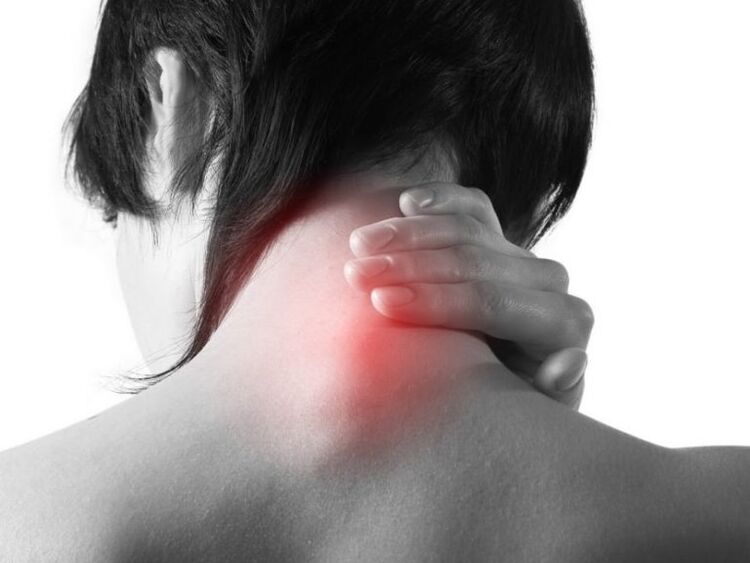
Emergency experts arrive and either solve the problem on the spot or take the patient to the hospital.After diagnosis, a prescription for treatment of cervical osteochondrosis will be prescribed.Usually, after first aid, the patient will be discharged to receive treatment in the outpatient clinic.
drug
Treatment of cervical osteochondral bone marrow disease is based on the use of such drugs:
- Nonsteroids with anti-inflammatory properties.These drugs get rid of the symptoms of the disease.The funds also block the inflammatory process and save traumatic nerves from the swelling.Tablets are consumed 2-3 times a day after eating.The treatment time is 2-3 weeks.
- musorelaxant.They got rid of muscle cramps and muscle tissue.
- Corticosteroids.These are hormone drugs.Prescriptions are only prescribed if other drugs prove inefficient.Drugs have a lot of contraindications and side effects, so you can only use them for treatment as directed by your doctor.
- Diuretic.Relieve excessive fluid in the body.Therefore, these drugs help to remove soft tissue swelling at the site of the inflammatory process.
- piece.Usually, doctors prescribe medications subcutaneously or intramuscularly.These drugs are divided into several points in the injured vertebrae area.This allows you to stop pain syndrome.
- Cartilage protector.They ceased the development of pathology and helped to restore injured cartilage.
- B vitamin B improves metabolism and neuromuscular conductivity.
surgical
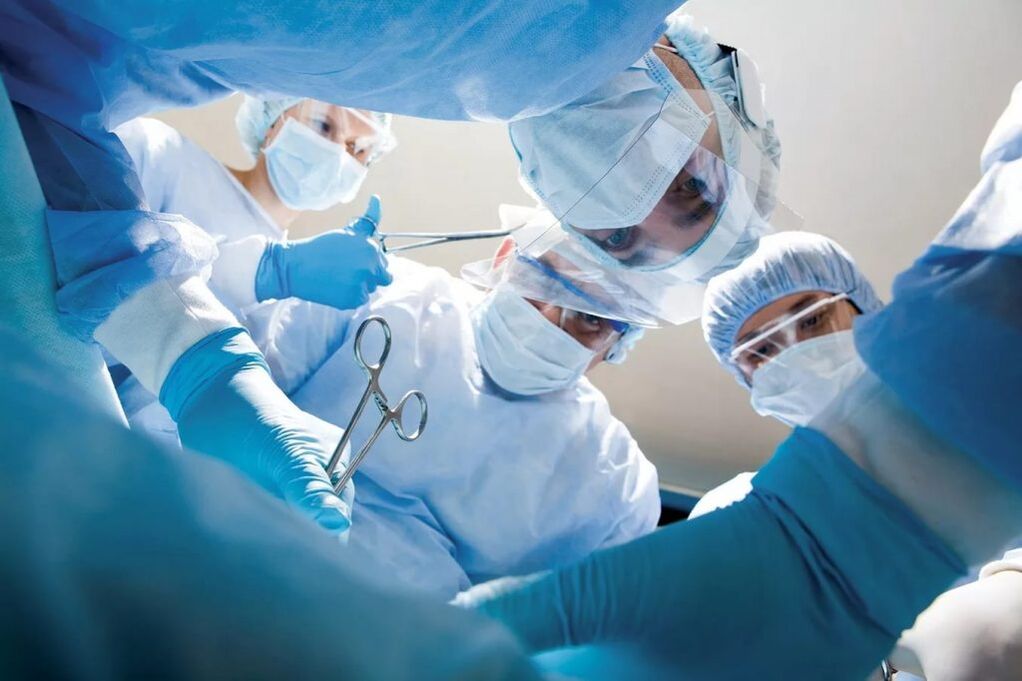
In the final stage of disease development, surgical intervention was performed only under the ineffectiveness of conservative treatment.The evaluation of treatment results will be conducted within six months.In the absence of effect, surgical intervention was performed.If unbearable pain or limb paralysis occurs, the procedure can be prescribed.
Neck gymnastics
The treatment of house pathology is based not only on the use of drugs, but also on the performance of special exercises.Exercise therapy is prescribed by a doctor.The course is only conducted during the disease remission period.To get rid of intervertebral head pinch, this type of exercise is recommended:
- Lie on your stomach and focus on the floor, lifting your head and body.Practice repeat 2-3 times on the top of 2-3 minutes.
- They lay on their stomachs, repeating one after another, touching the floor of the floor.The number of repetitions for each direction is 7.
- Sitting on the floor, lean forward to the chin on your chest, then lean back and back.The exercise was performed 10-15 times.
- Sit on your forehead and press your palm.Then press their heads onto the palms.The number of repetitions is 2-3.
- Stay behind, they first rotate their heads and then rotate in the other direction.The number of repetitions is 10.
physiotherapy
In order to get rid of cervical osteochondrosis, physical therapy procedures are also stipulated.This treatment helps to get rid of the symptoms of the disease and helps to restore injured cartilage.The following procedures are usually stipulated:
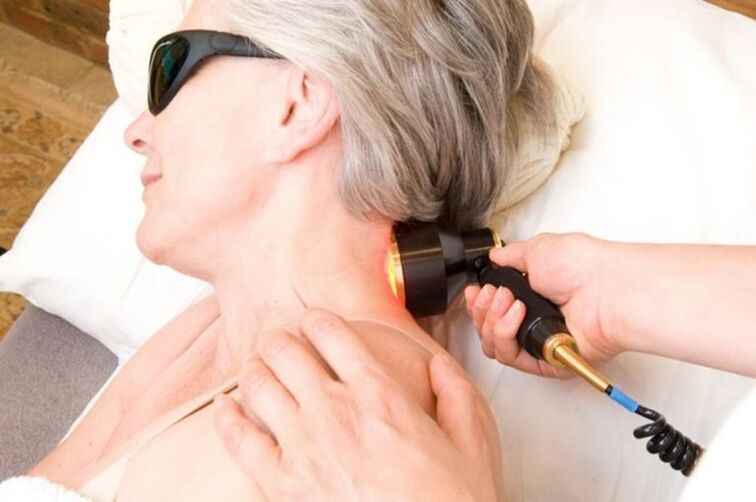
- Laser therapy.The essence of this method is the effect of laser on the spine-affected area.This can improve blood microcirculation and stop the inflammatory process.
- Electrophoresis.The procedure is performed with painkillers.The essence of this method is the effect on the injured part of the human body. The current is very small and is used to pass ions and drugs in the damaged area of the spine through.
- ultrasound.This process improves the metabolic process that occurs in cells, stops the pain syndrome and stops the inflammatory process.
- Magnetic therapy.Relieves swelling in soft tissues and eliminates pain syndrome.
To improve the effectiveness of treatment, alternative treatments can also be prescribed:
- Massage the cervical and chest area;
- Manual therapy;
- Acupuncture and other procedures.
Nutrition
If you do not follow certain nutritional rules, treatment for cervical osteochondrosis will be ineffective.Diet will help:
- Avoid the occurrence of lack of beneficial substances, because vitamins and minerals are involved in the metabolic process of intervertebral disc cells;
- Normalize body weight, which will reduce the load on the spine;
- To minimize the possibility of changes in vascular sclerosis, the risk of impaired blood supply to the brain is reduced.

The basic principles of appropriate nutrition for cervical osteochondrosis:
- Diet should be with a daily dose of 1200-1500;
- Take food 5-6 times a day;
- Observe drinking protocols to prevent dehydration of fabrics from the intervertebral discs - drink at least 1.5 liters of liquid per day;
- Limit salt consumption because it retains the fluid in the body, causing the appearance of swelling tissue;
- Limit the consumption of starch and flour products;
- Exclude fat from diet, fried, spicy, smoked;
- Refuse alcohol and sweet carbonated drinks, as well as juices in boxes;
- The menu introduces fresh vegetables and fruits, lean meat, lean meat, cereals, milk and yogurt products with minimal fat content.
Tibetan applicator
Even if there is cervical osteochondrosis, doctors recommend using Tibetan applicators to improve the condition.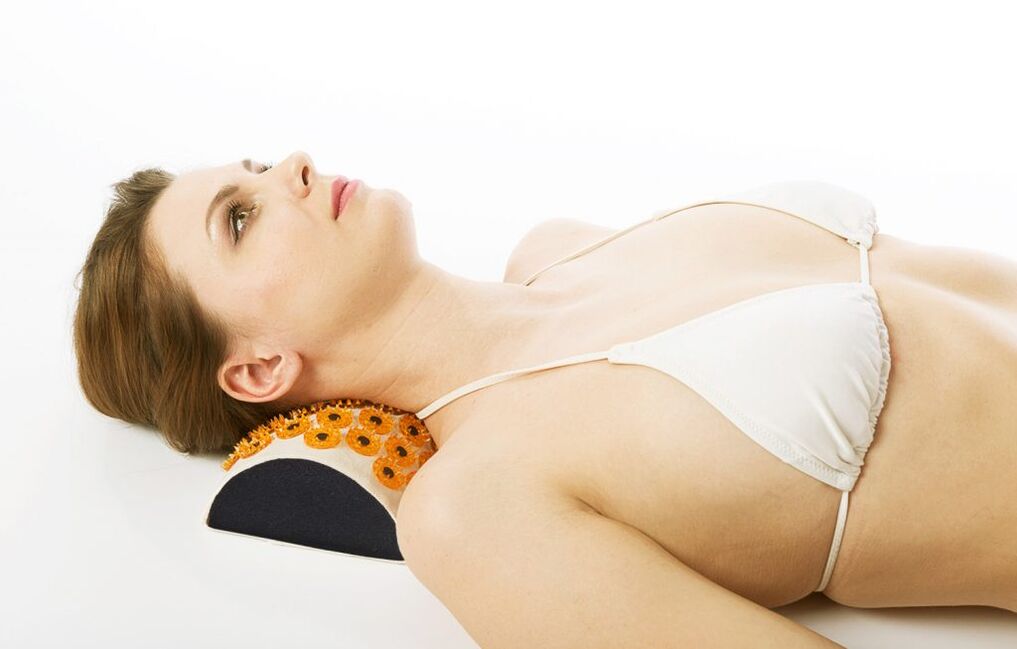 This is a spike device made of plastic that affects the skin.The patient applies the applicator to the problem area and takes the position of the lie.As a result, epidermal receptors involved in human physiological processes are very angry.
This is a spike device made of plastic that affects the skin.The patient applies the applicator to the problem area and takes the position of the lie.As a result, epidermal receptors involved in human physiological processes are very angry.
This process gives the following results:
- Guidance sleep has been normalized, and the quality and duration of night rest improves;
- Pain syndrome stops;
- Improved blood microcirculation;
- Recovery of joint mobility;
- Improved performance.
There are contraindications for Tibetan applicators:
- epidermal pathology;
- Diseases caused by infection;
- Vascular disease;
- Tumor pathology of malignant nature.
You can only use the device after consulting an expert.
Folk treatment
The use of non-traditional medicine is another way to treat cervical osteochondrosis.Such drugs are only used with the permission of a doctor.Public medicine improves the effectiveness of drug treatment.For the treatment of the disease, it is impossible to use as a standalone drug.Here are recipes for preparing non-traditional medicine for osteochondrosis.
Cabbage compression

A fresh cabbage leaf is slightly beaten with a hammer to soften it.Afterwards, it is fixed in the problem area and isolates.The compression stayed for several hours.The process is performed daily.You can use horseradish leaves instead of cabbage slices.
Jump-based ointment
Necessary components:
- Cut the cone into powder - 1 large spoon;
- Butter - 1 tablespoon.
Products are connected and mixed.The resulting composition is made with the affected area and the insulating bandage is secured.The compression time ranges from minutes to hours.The process is performed daily.The ointment is stored in the refrigerator.
Honey - Cartel Compression
Necessary ingredients:
- Crushed raw potatoes - 1 large spoon;
- Honey - 1 tablespoon.
Mix the assembly and place it in a piece of gauze.Compress and fix on the problem area for 20 minutes.This process is performed every 7 days.
Prevent disease
The following preventive measures will help avoid pathology:
- Live an active lifestyle - participate in sports, the best swimming;
- Enrich your diet with products containing magnesium and calcium;
- A few times a day do a warm job while sitting down to work;
- Use orthopedic bedding for nighttime breaks;
- Take a hot bath for 10 minutes every day;
- Give up excessive physical effort;
- Visit the doctor regularly and perform timely pathological treatment, which may cause the occurrence of cervical vertebrae bones.
What is dangerous osteochondral disease on the neck
The main danger of this disease is that the lack of timely and qualified treatment can lead to complete fixation of the joints, resulting in disability.In addition, the pinching of the cervical spine will have a negative impact on the blood supply to the brain.As a result, headaches and other appropriate illnesses appear.Therefore, you cannot ignore the pathology.

Cervical osteochondrosis is the pathology of the spine, which can lead to sad consequences without timely qualified treatments.To prevent this from happening, it is recommended to consult a doctor after the first symptom of the disease.














































